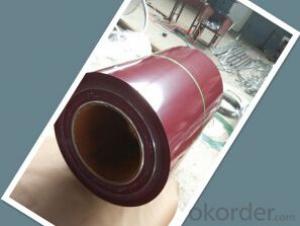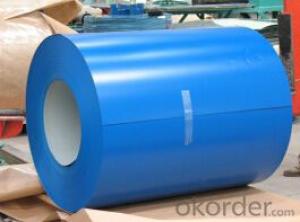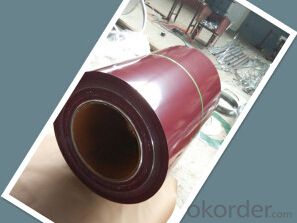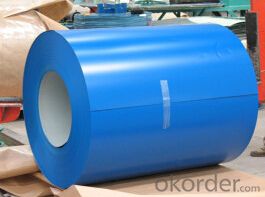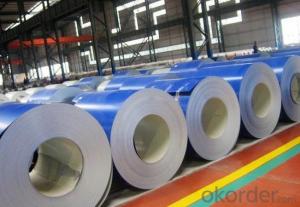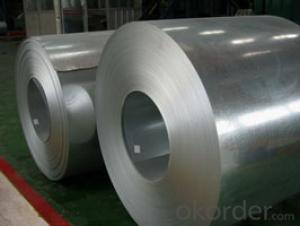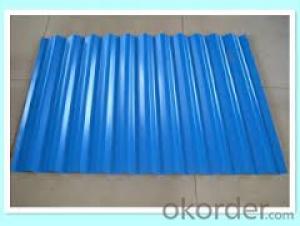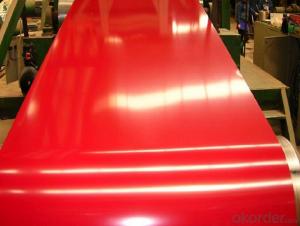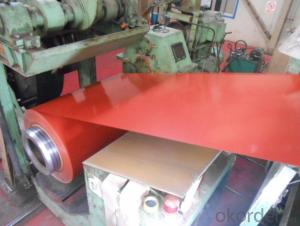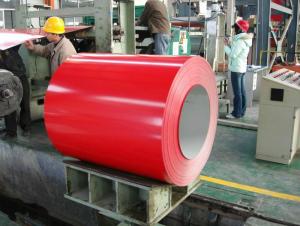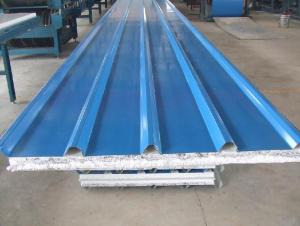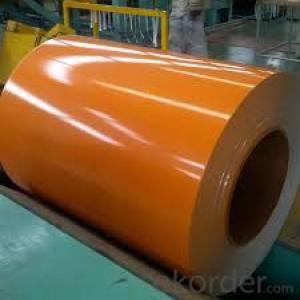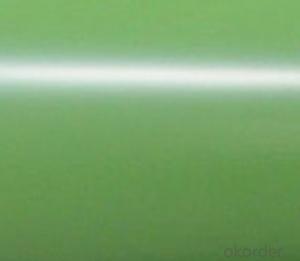Prepainted Steel Coils with Plain or Matt Surface
- Loading Port:
- Tianjin
- Payment Terms:
- TT OR LC
- Min Order Qty:
- 25 m.t.
- Supply Capability:
- 10000 m.t./month
OKorder Service Pledge
OKorder Financial Service
You Might Also Like
Prepainted Steel Coils description:
Model NO.:0.5*1000*C
Surface Treatment:Coated
Certification:ISO, SGS, BV, SGS & ISO9001:2008
Technique:Cold Rolled
Standard:ASTM, JIS, GB, AISI, DIN, BS
Application:Sandwich Panels, Corrugated Steel Sheets
Edge:Slit edge
Stock:Not Stock
Steel Grade:CGCC & Cglcc
Thickness:0.16~1.20mm
Color:Ral Color
Coil Width:600~1250mm
Coil ID:508/610 Mm
Export Markets:Global
Additional Info.
Trademark:HZZN
Packing:Seaworthy, Standard Export Package, in Container
Standard:0.50*1000*C
Origin:China
HS Code:7210701000
1) Standard: JIS G3312 CGCC & CGLCC, equivalent to ASTM A755M, EN10169
2) Grade: CGCC and CGLCC
3) Hardness: Both soft and full hard are available
4) Surface finish: With or without protect film covered
5) Thickness range: 0.16-1.20mm
6) Coil width: 600-1250mm, general 914mm, 1000mm, 1220mm and 1250mm.
7) Shape: Both sheet and coil are available
8) Coating: Z40 to Z275, or AZ30 to AZ150
9) Paint thickness: Top 5 um + (10-20) um polyester, Reverse 5-10 um Epoxy
10) Color: any RAL code, or according to customer's sample
11) Coil weight: 3-6 tons, or according to customer's requirements
12) Max loading in one 20ft container: 25 tons generally
13) MOQ: 25 tons for each thickness or color;
14) Delivery time: 2 weeks or one month generally.
15) Applications: Widely used for roof tiles, outer walls, ovens, explosive-proof steel, electrically controlled cabinets, and industrial freezers in the residential and industrial buildings
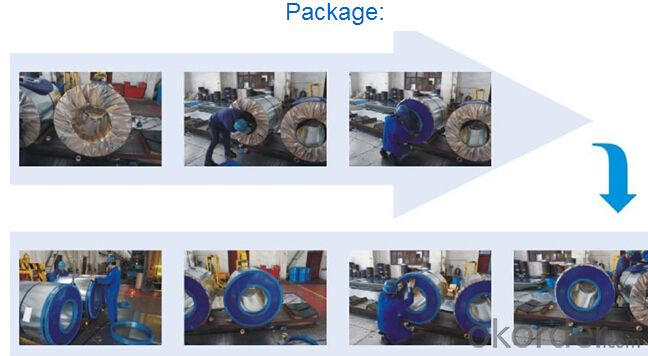
specification:
| Prepainted galvanized steel coil ( PPGI ) | Prepainted galvalume steel coil ( PPGL ) | |
| Standard | JIS G3312 CGCC ASTM A755M EN10169 | J IS G3322 CGLCC AS 1397 G2+AZ |
| Valid thickness | 0. 16 ~1. 2 0mm | 0. 16 ~1. 2 0mm |
| Coil width | 600~1250mm | 600~1250mm |
| Coil ID | 508mm & 610mm | 508mm & 610mm |
| Coil weight | 3~5 tons | 3~5 tons |
| Coating | 4 0~275 g/m2 | AZ30 to AZ150 |
| Paint t hickness , top side | 15~25 microns | 15~25 microns |
| P aint t hickness , reverse | 5~7 microns or 15~25 microns | 5~7 microns or 15~25 microns |
| Color | any RAL code | any RAL code |
| Package | vertical, eye to sky & horizontal | vertical, eye to sky & horizontal |
| MOQ | 25 tons | 25 tons |
- Q: What is the process of slitting steel coils into narrower strips?
- The process of slitting steel coils into narrower strips involves unwinding the steel coil and passing it through a set of rotating circular blades. These blades cut the coil into narrower strips of the desired width. The strips are then rewound onto separate coils or packaged for further processing. This slitting process allows for the production of multiple narrower strips from a single large coil, making it more versatile and efficient for various applications.
- Q: What are the different methods of coil welding for steel coils?
- There are several different methods of coil welding for steel coils, each with its own advantages and disadvantages. Here are some of the most commonly used methods: 1. Resistance Welding: This method involves passing an electric current through the coils to generate heat, which then fuses the two ends together. Resistance welding is a fast and efficient process that produces strong and reliable welds. It is commonly used in industries where high-speed production is required. 2. Arc Welding: Arc welding uses an electric arc between an electrode and the workpiece to create a weld. This method can be further divided into different processes, such as shielded metal arc welding (SMAW), gas metal arc welding (GMAW), and flux-cored arc welding (FCAW). Arc welding provides good penetration and can be used on a wide range of steel coils. 3. Laser Welding: Laser welding utilizes a high-powered laser beam to melt and fuse the two ends of the coils together. This method offers precise control, high welding speeds, and minimal distortion. It is often used in applications where precision and aesthetics are crucial, such as the automotive and electronics industries. 4. Induction Welding: Induction welding involves heating the coils using electromagnetic induction. The heat generated melts the edges, which are then pressed together to form a weld. This method is particularly suitable for thin-gauge steel coils and provides good control over the welding process. 5. High-Frequency Welding: High-frequency welding utilizes high-frequency current to heat and weld the coils together. This method is commonly used for pipes and tubes and offers high production rates and good weld quality. 6. Friction Welding: Friction welding uses the heat generated by rubbing the two ends of the coils together to create a weld. This method is fast, reliable, and produces strong joints. It is often used in applications where high-strength welds are required, such as the automotive and aerospace industries. These are just a few of the different methods of coil welding for steel coils. The choice of method depends on factors such as the type and thickness of the steel, the required weld strength, production speed, and overall project requirements.
- Q: why were guns, germs and steel absent within America?
- i dont really understand this question but if it means to how it was before then it was absent because the native americans were not into technology so they obviously had no guns created that was something that they had traded to get from europe as for the germs i ddo not know about thta really except for if it means that common disease and one of the diseases most used in history books is malaysa from mosquitos but when they had traded with europe they got all sorts of diseases now for steel the only reason i remember them traveling for is for gold and i dont remember them ever looking for it until 13 colonies were established as you can see im not exactly sure about germs and steels but i know that the guns part is correct
- Q: What is the major disadvantage of hardened steel? Do you think this form of iron would be wear resistant and retain a sharpened edge?
- The major disadvantage of hardened steel is that it is very brittle unless it is tempered. Hardened steel would be wear resistant, and would hold an edge as long as you don't cut anything harder than a boiled egg - the impact of the knife on a cutting board would shatter it.
- Q: How do steel coils contribute to the manufacturing of steel furniture?
- Steel coils are an essential component in the manufacturing of steel furniture as they serve as the raw material for creating various steel components. These coils are used to form and shape the different parts of the furniture, such as frames, legs, and supports. The coils are unwound and cut into the required lengths, then passed through various machines like presses and rollers to bend, shape, and join them together. This process allows for the customization and fabrication of the steel furniture, ensuring strength, durability, and the ability to withstand heavy loads. Overall, steel coils play a crucial role in shaping and forming the structural elements of steel furniture, providing the necessary strength and stability to the finished product.
- Q: I am looking for steel. I need a lot.
- Ryerson-Tull sells all sorts of steel. As does Liebovitch. I'm not what the phone numbers are to these places, but I'm sure you could find them on the internet.
- Q: How are steel coils used in the production of telecommunications equipment?
- The production of telecommunications equipment commonly involves the use of steel coils, which offer structural support and durability. These coils are utilized to fabricate different components, including cabinets, racks, and enclosures. A significant application of steel coils in telecommunications equipment is seen in the manufacturing of cabinets. These cabinets serve as housing for the delicate electronic components and wiring utilized in telecommunications systems. Steel coils are typically shaped to form the cabinet structure, providing a robust and dependable enclosure for the equipment. The steel material also offers protection against external factors such as impacts, dust, and moisture, ensuring the longevity and integrity of the telecommunications equipment. Steel coils also find application in the production of racks for telecommunications equipment. These racks are designed to organize and provide accessibility to multiple devices, including servers, switches, and routers. The strength and rigidity of steel coils make them an ideal material for constructing these racks, ensuring they can bear the weight of multiple devices and withstand the constant handling and movement that occur in telecommunication environments. Moreover, steel coils are used to manufacture enclosures for telecommunications equipment. These enclosures act as protective casings, safeguarding sensitive electronic components from external influences such as electromagnetic interference and physical damage. Steel coils are often formed into specific shapes and sizes to create these enclosures, providing a sturdy barrier that shields the equipment from various external threats. In conclusion, steel coils play a crucial role in the production of telecommunications equipment by offering structural support, durability, and protection. They are employed in the creation of cabinets, racks, and enclosures, which ensure the proper functioning and longevity of the sensitive electronic components used in telecommunication systems.
- Q: How are steel coils used in the production of fireproof doors?
- Steel coils are used in the production of fireproof doors as they are the primary material for constructing the door's core. The steel coils are shaped and layered to create a strong and heat-resistant core, which provides the necessary structural integrity and fire resistance required for fireproof doors.
- Q: okay i got some questions of the steel plow.1st - who inveneted it? where and when?2nd - how did it work? what is it used for? what is it made of? how is it produced?okay guys thank you very much. remember best answer gets best answer 10 points!
- You want ot read up on American John Deere; he madethe first plow capable of cutting the virgin sod of the great planes.
- Q: How are steel coils used in the production of appliances?
- Steel coils are used in the production of appliances as a primary material for constructing the various components, such as the outer shells, frames, and internal structures. The coils are processed and shaped into specific sizes and forms to meet the requirements of different appliances. Additionally, steel coils provide strength, durability, and a sleek appearance to the finished appliances.
Send your message to us
Prepainted Steel Coils with Plain or Matt Surface
- Loading Port:
- Tianjin
- Payment Terms:
- TT OR LC
- Min Order Qty:
- 25 m.t.
- Supply Capability:
- 10000 m.t./month
OKorder Service Pledge
OKorder Financial Service
Similar products
Hot products
Hot Searches
Related keywords
